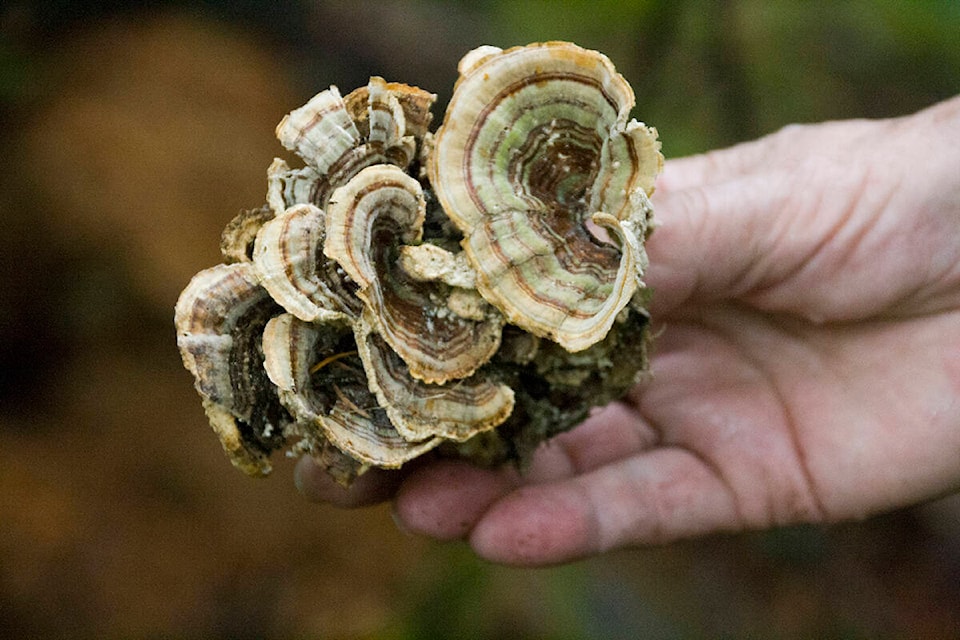By Jordan Copp, Local Journalism Initiative Reporter COAST REPORTER
If there ever was a behind-the-scenes star in the forests along the Sunshine Coast, it would have to be the mushrooms.
Jody “Shaggy Jack” Franklin said that last summer’s drought caused the worst season he had ever seen on the Coast, but that this year is looking much more promising.
“This year with something akin to an average rainfall coming back, we’re seeing mushroom productivity that was lacking last year, we’re seeing it rebound.
“So, for instance, our golden chanterelles, which in most years are extremely abundant — last year were very scarce because they have very deep mycelium and deep mycorrhizal connections,” said Franklin. “And now that we’re seeing a healthy rainfall, we’re seeing that chanterelle productivity come back.”
Jayun McDowell, co-founder of Meronwood Mycology Centre, has been foraging for mushrooms on the Coast for many years and has a different opinion on this year’s yield.
“Last year, there was nothing on the Coast even though the Island seemed to have lots of mushrooms, and this year has kind of been the same thing, people are not finding mushrooms.”
McDowell said she believes it was not only the drought, but also the higher temperatures which have inhibited mushroom growth.
Kristy Little-Wakatsuki has been foraging with her son, Roman, since he was two years old and says he is already almost better at mushroom foraging than her.
Recently, nine-year-old Roman, stumbled upon a substantial prize, a massive, 2 kg king bolete mushroom, something they would not have been able to do last year.
“There’s a lot of mushrooms right now but it was almost like they were pushed a bit dormant, like things were happening out of sync.”
She included that the summer droughts have weakened the structural integrity of downed trees and can make the forests dangerous when the rainy season arrives.
“What you would think is a tree that’s solid to step on are just like dry sponges inside because they’ve just almost disintegrated,” she said.
Little-Wakatsuki is one of many who enjoy mushroom foraging on the Coast. She said her love for mushrooms was intensified when she moved to the Coast and attended a mushroom festival at Madeira Park, where she purchased a mushroom book and met some local mycologists.
Those eager to forage the returning fungi need to be aware that despite their beautiful appearance, certain species of these delicate detritivores can be life-threatening if ingested.
Franklin has been leading a mushroom education program on the Sunshine Coast for six years, teaching beginners how to identify local mushrooms and where to find them.
Franklin said his main concern is for people who are going out into the forest to forage mushrooms to know what they’re doing.
He added that there are no “general rules” to identifying mushrooms such as “all purple mushrooms are poisonous,” and knowing how to accurately identify them will avoid serious health issues.
Franklin estimates that there are more than 1,000 species of mushroom in B.C. and 500 of those occur on the Sunshine Coast. “Before you consume any mushroom, you need to be able to 100 per cent identify its species.”
Dr. Moliehi Khaketla of Vancouver Coastal Health said that BC Drug and Poison Information Centre receives an average of 200 calls a year province-wide related to concerns over wild mushroom exposure.
Khaketla highlighted that this is a very conservative estimate of all of the ingestions that happen as many who get this type of exposure do not call the poison line she added that roughly two thirds of these calls are related to young children or toddlers.
Khaketla reaffirmed the importance of identifying any mushroom before eating it, using the death cap mushroom as an example — a commonly found, toxic, introduced species that look very similar to edible mushrooms.
A toll-free number is available for anyone who suspects they’ve had an accidental indigestion is 1-800-567-8911.
Franklin explained that the mushroom that we see above ground is the spore-bearing fruit body of the mycelial fungi that grow beneath the surface.
This mycelial fungi spreads out like a web and creates a mycorrhizal network between the roots, trees, stumps and other plants and creates a symbiotic relationship between them. “The mycelium is more like your blackberry bush, and the mushroom is more like your blackberry,” he said.
In droughts like last summer, the mycorrhizal growth is able to lay dormant and wait for ideal conditions.
“The problem would be in this era of climate change, what if we get four or five years in a row like that,” said Franklin. “Do we see the mycelium not able to get the water, the trees not absorbing enough? This can be something that can be potentially catastrophic for the forests.
“All of the trees in the forest on the West Coast are dependent on their relationships with the mycorrhizal fungi.”
READ ALSO: Vancouver Island expert offers practical advice on mushroom gathering
READ ALSO: Who controls mushroom harvesting on Indigenous lands?
